Bhubaneswar, the capital of the East Indian state of Odisha, lies in its coastal region. Together with Konark and Puri, it forms the Swarna Tribhuja or Golden Triangle of Odisha tourism. This ancient city makes an ideal starting point for the traveller who wishes to explore the magnificence of Kalinga architecture, worship at its grand temples or enjoy the beaches of Puri.
Bhubaneswar is 30 km from Cuttack, the commercial capital of Odisha. It is also an important business centre in its own right. Bhubaneswar is also the seat of State assembly. It is considered one of the fast growing cities in India, with its Manufacturing and Information technology advancements. With more than 100 educational institutes in the city, Bhubaneswar is also very popular for students from Eastern part of India.
Odia is the most common language spoken with in the city. However, with a culture shifting towards cosmopolitan manner, Hindi and English are very much understood and accepted.
With many Hindu temples, which span the entire spectrum of Kalinga architecture, Bhubaneswar is often referred to as a Temple City of India and together with Puri and Konark it forms the Swarna Tribhuja ("Golden Triangle"), one of eastern India's most visited destinations. The modern city was designed by the German architect Otto Königsberger in 1946, along with Jamshedpur and Chandigarh.
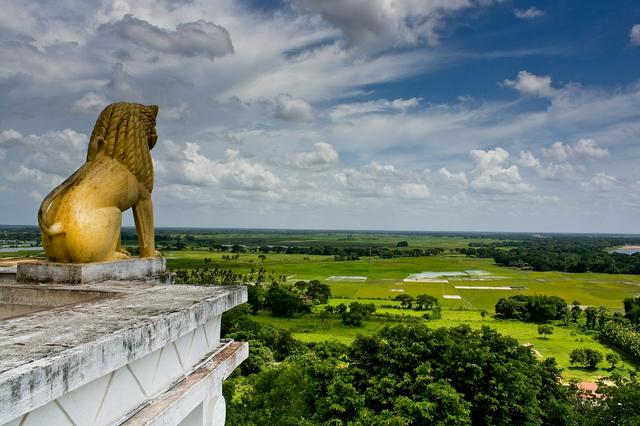
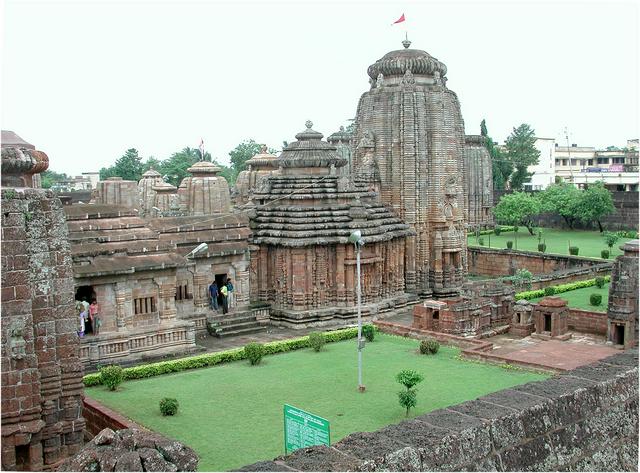
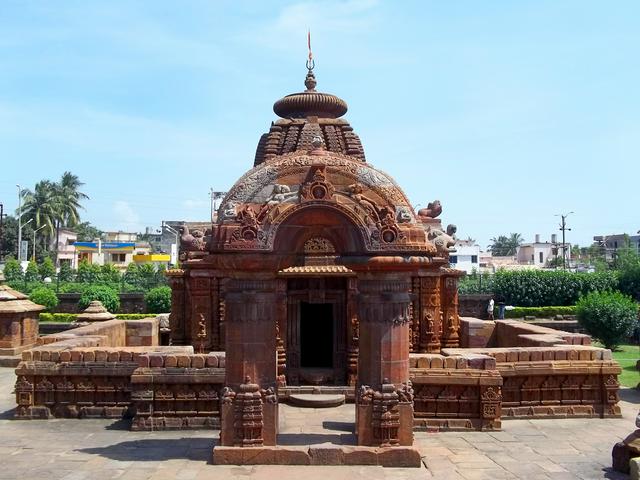
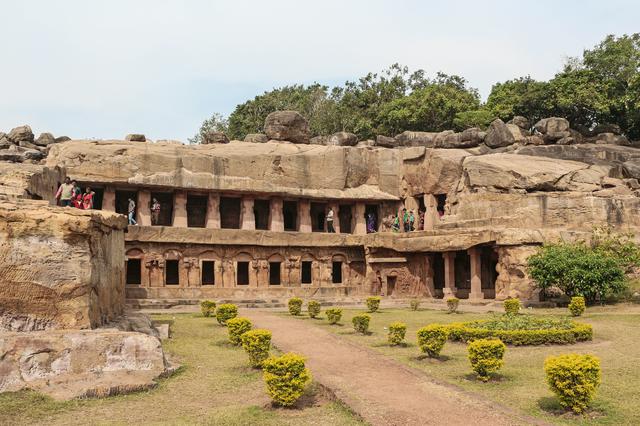
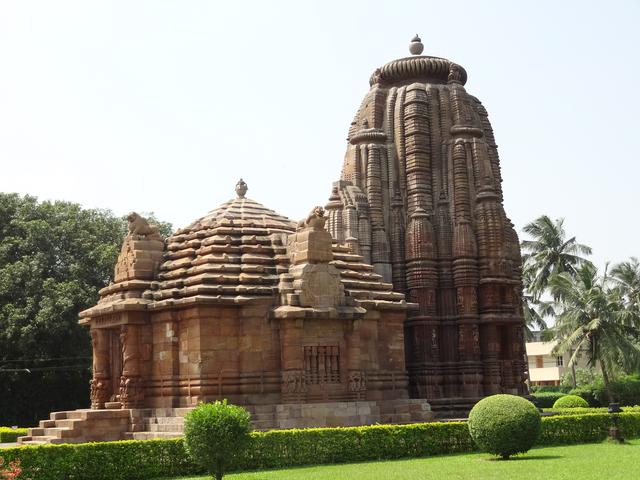
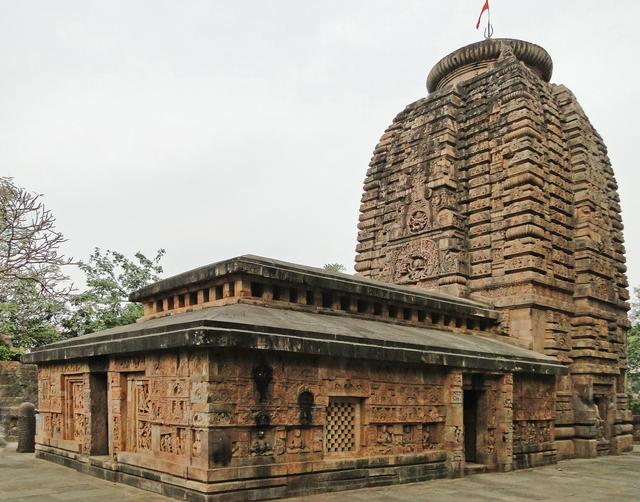 Temples are undoubtedly the most important attractions of this city. Bhubaneswar is an ancient city where the major religions of India, Buddhism, Hinduism and Jainism, have all had a presence during some time in its history. All the religions have left their architectural footprints here. In particular, this is a place where the Kalinga style of Hindu temple architecture flourished between the 10th and the 13th century; you will see some of the finest examples of the style here. Unfortunately, most temples do not allow entry to non-Hindus. Most of the oldest temples, around 400 of them, are concentrated around the Old Town area.
Temples are undoubtedly the most important attractions of this city. Bhubaneswar is an ancient city where the major religions of India, Buddhism, Hinduism and Jainism, have all had a presence during some time in its history. All the religions have left their architectural footprints here. In particular, this is a place where the Kalinga style of Hindu temple architecture flourished between the 10th and the 13th century; you will see some of the finest examples of the style here. Unfortunately, most temples do not allow entry to non-Hindus. Most of the oldest temples, around 400 of them, are concentrated around the Old Town area.
- Dhauli Giri, Dhauli Road (8km from the city. Looking down on the plains that bore witness to the gruesome war waged on Kalinga by the Mauryan emperor Ashoka, stand the rock edicts of Dhauli. It was here that King Ashoka, full of remorse after the Kalinga War in 261 BC, renounced his bloodthirsty campaign and turned to Buddhism. The edicts are a living testimony to the King's change of heart. He urges his administrators to rule the land with justice and compassion. The edicts are so remarkable that they have been excellently preserved, despite the fact that they date back to the 3rd century BC. A sculpted elephant, the symbol of the boundless powers of Lord Buddha, tops the rock edicts. The Shanti Stupa or the peace pagoda, built through the Indo-Japanese collaboration, is on the opposite hill. Free.
- Khandagiri & Udayagiri, Khandagiri-Chandaka Road Khandagiri (Off AH45 (NH16). 06:00-18:00. These twin hills served as the site of an ancient Jain monastery which was carved into cave like chambers in the face of the hill. Dating back to the 2nd century BC, some of the caves have beautiful carvings. The Rani Gumpha (Queen's Cave), one of the largest and double-storied, is ornately embellished with beautiful carvings. In the Hati Gumpha (Elephant Cave), King Kharavela has carved out the chronicles of his reign. At the summit of Udayagiri is an excavated Jain temple. Khandagiri has a operating Jain temple. Udayagiri: ₹5 for Indians, ₹100 for foreigners. Entry to Khandagiri caves is free.
- Lingaraj Temple, Lingaraj Road, Old Town, +91-674-234 0105. 08:00-12:00, 16:00-20:00. The 10th or 11th-century Lingaraja temple of Bhubaneswar has been described as "the truest fusion of dream and reality". A rare masterpiece, the Lingaraja temple has been rated one of the finest examples of purely Hindu temple in India by Ferguson, the noted art critic and historian. Every inch of the surface of the 55 m-high Lingaraja temple is covered with elaborate carvings. Sculpture and architecture fused elegantly to create a perfect harmony. Non-Hindus are not permitted inside; however, there is an elevated viewing platform next to one of the boundary walls. To reach the platform, face the temple's main entrance and walk around to the right. There is a laneway leading to the back of the temple and the platform. Photography is prohibited inside the temple complex: the platform offers a good vantage point to photograph the temple. Just be careful of the scammers who try to befriend you, saying they are in charge of the temple, then make you sign into the "guestbook", which is just the notebook full of random names and "donations", forcing you to "donate" as well. One of them reports any foreign people in the viewpoint to the second one, who comes later on the blue scooter, trying to trick you. Near the temple is Bindu Sarovara, a large lake that is reputed to have a drop of water from each of all the holy rivers of India. Free, offerings accepted.
- Mukteshwara Temple. Dating back to the 10th century, this temple marks an important transition point between the early and the later phases of the Kalinga architecture. The highlight is the magnificent torana: the decorative gateway, an arched masterpiece, reminiscent of Buddhist influence in Odisha. This temple is considered to be the gem of Odishan architecture. Mukteswara means "Lord of freedom." The Temple complex also houses the siddhesvara Temple. Free, offerings accepted.
- Rajarani Temple. This temple got its name from a red-gold sandstone used, which is called Rajarani locally. It has no presiding deity but many intricately carved figurines in various stages of daily chores.
- Sri Krishna-Balarama Mandir, ISKCON, on NH5 (ask the autorickshaw drivers, about ₹40 from town. Non-Hindus and foreigners who desire to visit a Hindu temple can go to this temple. The devotees are friendly and there is a cheap and clean vegetarian restaurant.
- Traffic Mahadev. A small temple which acts as a road divider.
- Ananta Vasudeva Temple. This 13th-century temple is on the eastern side of Bindu Saravar. It is dedicated to Lord Krishna and Krishna, Balaram and Subhadra are worshipped out here. It is first of the large temples of Odisha.
- Parasuramesvara Temple. Surise - Sunset. Dating to 650 AD this is the oldest surviving temple in Bhubaneswar, and possibly Odisha. The temple consists of two parts, Vimana and Jagamohan. The temple is dedicated to Lord Shiva. Free.
- Odisha State Museum. Housing a rich collection of sculptures, coins, copper plates, stone inscriptions, lithic and bronze age tools, rare manuscripts written on palm leaves, traditional and folk musical instruments. Rare epigraphic records are preserved in the Epigraphy Gallery.
- Museum of Tribal Art & Artefacts, CRPF Square. Gives an impressive insight into the culture of the many different tribes living in and around Odisha. Tools, clothes and artwork are presented over several halls. In every area a guide of the museum will take care of you and give you extensive explanations. No entrance fee.
Odisha State Museum. Housing a rich collection of sculptures, coins, copper plates, stone inscriptions, lithic and bronze age tools, rare manuscripts written on palm leaves, traditional and folk musical instruments. Rare epigraphic records are preserved in the Epigraphy Gallery.
Museum of Tribal Art & Artefacts, CRPF Square. Gives an impressive insight into the culture of the many different tribes living in and around Odisha. Tools, clothes and artwork are presented over several halls. In every area a guide of the museum will take care of you and give you extensive explanations. No entrance fee.
- Nandankanan Zoo, Nandankanan Road, Khordha Barang (About 15 km from the city. April-September: 07:30-17:30. October-March: 08:00-17:00, closed Mondays. The zoo has some rare species of animals and is particularly well known for white tigers. There is a nice lake inside for boating and a ropeway, which, as of 2015, has been non-functional for 3 years. There is also the Botanical Garden is adjacent to the zoo. Avoid visiting the park on weekends when it gets crowded. Entry: ₹20 for Indian adults, ₹5 for Indian children between 3-12yrs, ₹100 for foreigners (you get a map free), Free for handicapped visitors. ₹50 for the safaris - the tickets are sold together even though the prices are quoted separately. Aquarium: ₹10 for adults, ₹5 for children, Paddle Boat: ₹25 for a 2-seater, ₹50 for a 4-seater and ₹100 for Family Boat. There are charges quoted for cameras, but no one seems to care about mobile cameras. ₹50/person for "Battery Operated Vehicles", but they will insist that you take on the entire 15-seater vehicle for ₹750..
- Deras Dam, near Chandaka Sanctuary (around 20 km away from the Bhubaneswar Baramunda Busstand. A pristine, quiet lake in the midst of the nature.
Nandankanan Zoo, Nandankanan Road, Khordha Barang (About 15 km from the city. April-September: 07:30-17:30. October-March: 08:00-17:00, closed Mondays. The zoo has some rare species of animals and is particularly well known for white tigers. There is a nice lake inside for boating and a ropeway, which, as of 2015, has been non-functional for 3 years. There is also the Botanical Garden is adjacent to the zoo. Avoid visiting the park on weekends when it gets crowded. Entry: ₹20 for Indian adults, ₹5 for Indian children between 3-12yrs, ₹100 for foreigners (you get a map free), Free for handicapped visitors. ₹50 for the safaris - the tickets are sold together even though the prices are quoted separately. Aquarium: ₹10 for adults, ₹5 for children, Paddle Boat: ₹25 for a 2-seater, ₹50 for a 4-seater and ₹100 for Family Boat. There are charges quoted for cameras, but no one seems to care about mobile cameras. ₹50/person for "Battery Operated Vehicles", but they will insist that you take on the entire 15-seater vehicle for ₹750..
Deras Dam, near Chandaka Sanctuary (around 20 km away from the Bhubaneswar Baramunda Busstand. A pristine, quiet lake in the midst of the nature.
Dhauli Giri, Dhauli Road (8km from the city. Looking down on the plains that bore witness to the gruesome war waged on Kalinga by the Mauryan emperor Ashoka, stand the rock edicts of Dhauli. It was here that King Ashoka, full of remorse after the Kalinga War in 261 BC, renounced his bloodthirsty campaign and turned to Buddhism. The edicts are a living testimony to the King's change of heart. He urges his administrators to rule the land with justice and compassion. The edicts are so remarkable that they have been excellently preserved, despite the fact that they date back to the 3rd century BC. A sculpted elephant, the symbol of the boundless powers of Lord Buddha, tops the rock edicts. The Shanti Stupa or the peace pagoda, built through the Indo-Japanese collaboration, is on the opposite hill. Free.
Khandagiri & Udayagiri, Khandagiri-Chandaka Road Khandagiri (Off AH45 (NH16). 06:00-18:00. These twin hills served as the site of an ancient Jain monastery which was carved into cave like chambers in the face of the hill. Dating back to the 2nd century BC, some of the caves have beautiful carvings. The Rani Gumpha (Queen's Cave), one of the largest and double-storied, is ornately embellished with beautiful carvings. In the Hati Gumpha (Elephant Cave), King Kharavela has carved out the chronicles of his reign. At the summit of Udayagiri is an excavated Jain temple. Khandagiri has a operating Jain temple. Udayagiri: ₹5 for Indians, ₹100 for foreigners. Entry to Khandagiri caves is free.
Lingaraj Temple, Lingaraj Road, Old Town, +91-674-234 0105. 08:00-12:00, 16:00-20:00. The 10th or 11th-century Lingaraja temple of Bhubaneswar has been described as "the truest fusion of dream and reality". A rare masterpiece, the Lingaraja temple has been rated one of the finest examples of purely Hindu temple in India by Ferguson, the noted art critic and historian. Every inch of the surface of the 55 m-high Lingaraja temple is covered with elaborate carvings. Sculpture and architecture fused elegantly to create a perfect harmony. Non-Hindus are not permitted inside; however, there is an elevated viewing platform next to one of the boundary walls. To reach the platform, face the temple's main entrance and walk around to the right. There is a laneway leading to the back of the temple and the platform. Photography is prohibited inside the temple complex: the platform offers a good vantage point to photograph the temple. Just be careful of the scammers who try to befriend you, saying they are in charge of the temple, then make you sign into the "guestbook", which is just the notebook full of random names and "donations", forcing you to "donate" as well. One of them reports any foreign people in the viewpoint to the second one, who comes later on the blue scooter, trying to trick you. Near the temple is Bindu Sarovara, a large lake that is reputed to have a drop of water from each of all the holy rivers of India. Free, offerings accepted.
Mukteshwara Temple. Dating back to the 10th century, this temple marks an important transition point between the early and the later phases of the Kalinga architecture. The highlight is the magnificent torana: the decorative gateway, an arched masterpiece, reminiscent of Buddhist influence in Odisha. This temple is considered to be the gem of Odishan architecture. Mukteswara means "Lord of freedom." The Temple complex also houses the siddhesvara Temple. Free, offerings accepted.
Rajarani Temple. This temple got its name from a red-gold sandstone used, which is called Rajarani locally. It has no presiding deity but many intricately carved figurines in various stages of daily chores.
Sri Krishna-Balarama Mandir, ISKCON, on NH5 (ask the autorickshaw drivers, about ₹40 from town. Non-Hindus and foreigners who desire to visit a Hindu temple can go to this temple. The devotees are friendly and there is a cheap and clean vegetarian restaurant.
Traffic Mahadev. A small temple which acts as a road divider.
Ananta Vasudeva Temple. This 13th-century temple is on the eastern side of Bindu Saravar. It is dedicated to Lord Krishna and Krishna, Balaram and Subhadra are worshipped out here. It is first of the large temples of Odisha.
Parasuramesvara Temple. Surise - Sunset. Dating to 650 AD this is the oldest surviving temple in Bhubaneswar, and possibly Odisha. The temple consists of two parts, Vimana and Jagamohan. The temple is dedicated to Lord Shiva. Free.
- Visit the scores of parks in the city. The planetarium for one is good. The science park refreshes your basics and takes you back to school days. Or go around the rose garden in CRPF square or the NICCO park.
- There may be an odd play going on in Rabindra Mandap, opposite the General Post Office. Or a dance program at Soochana Bhavan. This place also had radio news broadcasts (May1998) and a newspaper library. Visit places such as the hall of dance called Natamandira or the bhoga-mandapa, meaning hall of offering. Though these particular places can be found around the temple, the temple itself is off limits to non-Hindus.
- Enjoy the architecture of both ancient temples and the modern buildings in Sachivalaya Road.
- Take rest in one of the many small lassi shops and enjoy one of those cool yoghurt drinks. The lassi in Bhubaneswar is one of the best around.
Bhubaneswar is a great place to buy the handicrafts of Odisha. Silver filigree work, Applique work, items made of jute and papier mache items are some of the things you should consider taking back from your trip. The best place to buy these, though is not the city itself, but Pipili, 8 km away, on the route to Konark and Puri.
Colourful wooden icons of Lord Jagannath, sandstone icons and gemstones are a few other artifact that you can take back as mementos.
Hand-woven textiles, known as "handlooms" as in the rest of India, are exquisitely beautiful. For women: sarees and clothes that can be stitched into salwar kameezes, or kurtas. Shirts or kurtas for men are a good buy.
- Bhawani Mall.
- Big Bazar.
- Boyanika, Unit-2, Ashok Nagar Bhubaneshwar,, +91-674-2530230. Government-run handloom shop
- Market Building, Ashok Nagar, Bhubaneshwar, Odisha (via Raj Path Street and 4th street. 08:00-20:00, Closed on the last Monday of the month. This shopping complex run by the city's Municipal Corporation, is an excellent place to shop in Bhubaneswar. It has a multitude of shops, including Boyanika, and Utkalika, government run shops for handlooms and handicraft respectively, many other shops that sell handlooms, general cloth shops and various street vendors selling a wide range of products. Free.
- Pantaloon.
- The World.
- Esplanade Mall.
- Ekamra Haat.
- Pal Heights.
Bhawani Mall.
Big Bazar.
Boyanika, Unit-2, Ashok Nagar Bhubaneshwar,, +91-674-2530230. Government-run handloom shop
Market Building, Ashok Nagar, Bhubaneshwar, Odisha (via Raj Path Street and 4th street. 08:00-20:00, Closed on the last Monday of the month. This shopping complex run by the city's Municipal Corporation, is an excellent place to shop in Bhubaneswar. It has a multitude of shops, including Boyanika, and Utkalika, government run shops for handlooms and handicraft respectively, many other shops that sell handlooms, general cloth shops and various street vendors selling a wide range of products. Free.
Pantaloon.
The World.
Esplanade Mall.
Ekamra Haat.
Pal Heights.
- Country Kitchen, Bapuji Nagar (2.7 km from railway station. Spicy non-veg (mainly chicken) and separate veg restaurant.
- Dalma, Sachivalaya Marg, Chandrasekharpur (Unit 4 and KIIT Square. Authentic Odiya cuisine.
- Hare Krishna restaurant. A vegetarian restaurant.
- May Fair, 8-B, Jaydev Vihar-Ekamra Kanana Road, +91 674 666 0101.
- Mirch Masala; petrol pump Chandrashekharpur, Patia
Country Kitchen, Bapuji Nagar (2.7 km from railway station. Spicy non-veg (mainly chicken) and separate veg restaurant.
Dalma, Sachivalaya Marg, Chandrasekharpur (Unit 4 and KIIT Square. Authentic Odiya cuisine.
Hare Krishna restaurant. A vegetarian restaurant.
May Fair, 8-B, Jaydev Vihar-Ekamra Kanana Road, +91 674 666 0101.
Mirch Masala; petrol pump Chandrashekharpur, Patia
Not a place to really party out. But you can still chill at the following places.
- The Cellar. The latest addition to the city's night-life, where you can bowl, booze, and dance to Bollywood numbers from 21:00-23:00. This place attracts crowds.
- Desire,, Pal Heights. Good interiors, a good place for boozing and chilling out
- Rock On, opposite XIMB. Nice place to drink and to spend time with friends.
- Xstacy Lounge, Plot No 421B, Nandan Kanan Road, Above Canara Bank, Chandrasekharpur, +91 9437799977.
The Cellar. The latest addition to the city's night-life, where you can bowl, booze, and dance to Bollywood numbers from 21:00-23:00. This place attracts crowds.
Desire,, Pal Heights. Good interiors, a good place for boozing and chilling out
Rock On, opposite XIMB. Nice place to drink and to spend time with friends.
Xstacy Lounge, Plot No 421B, Nandan Kanan Road, Above Canara Bank, Chandrasekharpur, +91 9437799977.
Bhubaneswar is one of the greenest cities in India and it has a clean look, with adequate arrangement for dustbins made by the local municipal authorities. It is a generally peaceful city with hardly any history of violence. Nevertheless, you should avoid travelling late in night as the city tends to sleep early. Also, wear cool, white clothes in the summer.
The temples are managed in the age-old traditions so be aware of the Hindu rituals and traditions before entering them. Make sure to take off your footwear when you enter a temple or any household. Women in particular needed to be cautious in their clothing and hygiene, but things are more equitable now.
Summer tends to be hot.
Be aware of the many touts near to the tourist places: railways, temples and hotels. The 'Pandas' can be notorious if not shown respect. But be within your limits and a polite no (sometimes repetitive) will be ok to avoid getting scammed. In case you have an issue with an auto rickshaw driver or taxi then report immediately to a police outpost, or call 100.
- Baliguda, roughly 270km south from Bhubaneswar is home of Konds and Kutia konds. This is known as gateway to tribal tourism in the state. You can enjoy the nearby attractions like Belghar Sanctuary, Sapanala River Valley and Daringbadi, and get good hotel accommodation in Baliguda. Hotel Bivab is the best hotel to stay in this area.
- Bhitarkanika National Park, roughly 120 km North of Bhubaneswar, is home to the largest population of Saltwater Crocodiles (Crocodylus porosus) in all of India and is home to the largest known living crocodile at 23 feet in length. The park also features a wide variety of other wildlife, including a rare Albino Saltwater Crocodile.
- Chilika lake is regarded as the Mecca for birdwatchers. It is about 100 km from Bhubaneswar. The brackish water being the reason for its amazing bird diversity, it is the second largest brackish water lake in Asia.
- Konark
- Koraput - NALCO and HAL plants
- Manglajodi in Chilika is a fishing village on the banks of the lake. it would be better to contact the local conservation group Wild Odisha, who will suggest a good guide who can take you around and will help you hire a boat too.
- Puri
- Rock City Kodala is nicknamed Rock City, it is around 60 km from Brahmapur.
- Rourkela - Situated about 340 km North from Bhubaneswar. Direct train is available. Rourkela is one of the bigger cities of Odisha, and is also known as "Steel City".
- Sambalpur - Hirakud Dam and wildlife sanctuaries.
- Silk city Brahmapur (also spelled Berhampur) is nicknamed Silk City. It is around 180 km from Bhubaneswar.
- Simlipal National Park
Bhitarkanika National Park, roughly 120 km North of Bhubaneswar, is home to the largest population of Saltwater Crocodiles (Crocodylus porosus) in all of India and is home to the largest known living crocodile at 23 feet in length. The park also features a wide variety of other wildlife, including a rare Albino Saltwater Crocodile.
Chilika lake is regarded as the Mecca for birdwatchers. It is about 100 km from Bhubaneswar. The brackish water being the reason for its amazing bird diversity, it is the second largest brackish water lake in Asia.
Manglajodi in Chilika is a fishing village on the banks of the lake. it would be better to contact the local conservation group Wild Odisha, who will suggest a good guide who can take you around and will help you hire a boat too.
Rock City Kodala is nicknamed Rock City, it is around 60 km from Brahmapur.
Silk city [[Brahmapur]] (also spelled Berhampur) is nicknamed Silk City. It is around 180 km from Bhubaneswar.
